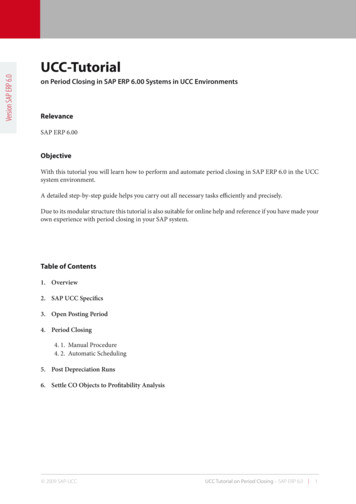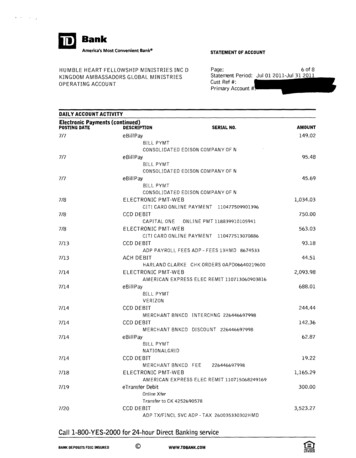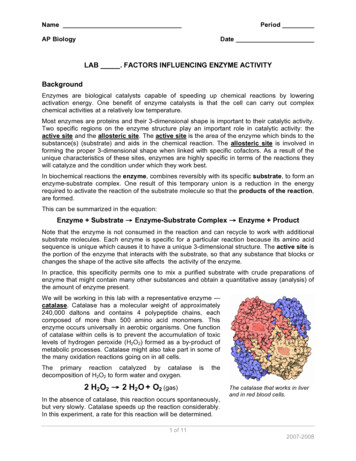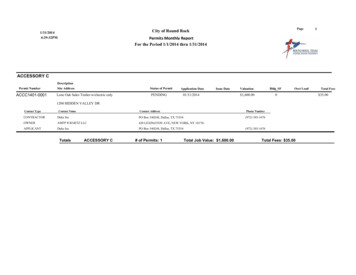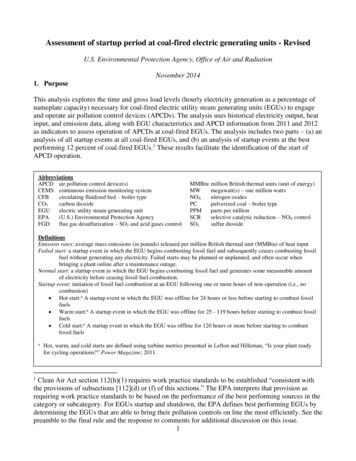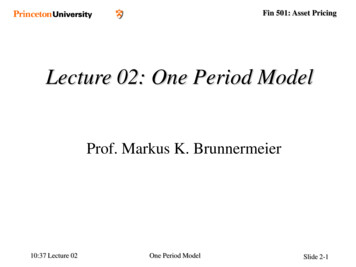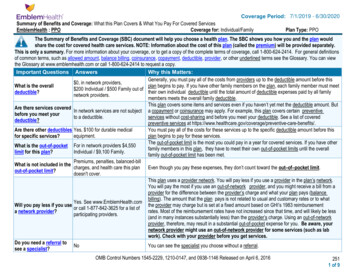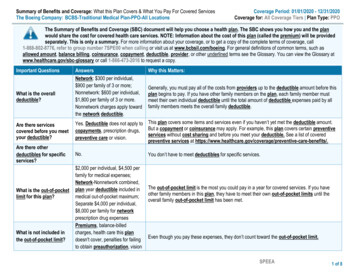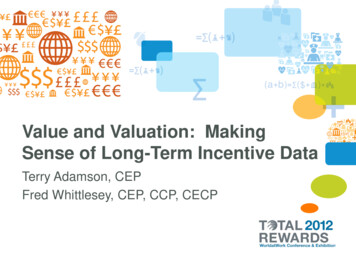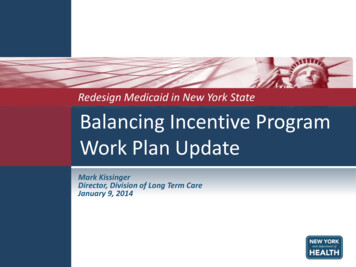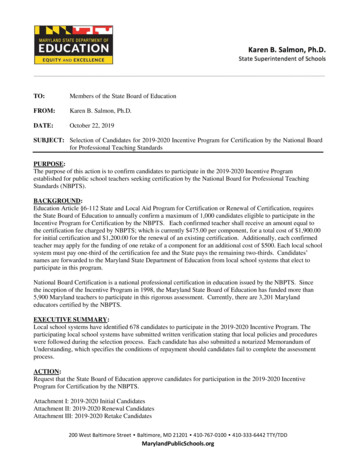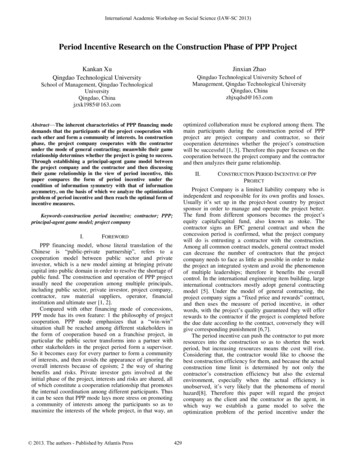
Transcription
International Academic Workshop on Social Science (IAW-SC 2013)Period Incentive Research on the Construction Phase of PPP ProjectJinxian ZhaoKankan XuQingdao Technological UniversityQingdao Technological University School ofManagement, Qingdao Technological UniversityQingdao, Chinazhjxqdsd@163.comSchool of Management, Qingdao TechnologicalUniversityQingdao, Chinajzxk1985@163.comAbstract—The inherent characteristics of PPP financing modedemands that the participants of the project cooperation witheach other and form a community of interests. In constructionphase, the project company cooperates with the contractorunder the mode of general contracting; meanwhile their gamerelationship determines whether the project is going to success.Through establishing a principal-agent game model betweenthe project company and the contractor and then discussingtheir game relationship in the view of period incentive, thispaper compares the form of period incentive under thecondition of information symmetry with that of informationasymmetry, on the basis of which we analyze the optimizationproblem of period incentive and then reach the optimal form ofincentive measures.optimized collaboration must be explored among them. Themain participants during the construction period of PPPproject are project company and contractor, so theircooperation determines whether the project’s constructionwill be successful [1, 3]. Therefore this paper focuses on thecooperation between the project company and the contractorand then analyzes their game relationship.II.Project Company is a limited liability company who isindependent and responsible for its own profits and losses.Usually it’s set up in the project-host country by projectsponsor in order to manage and operate the project better.The fund from different sponsors becomes the project’sequity capital\capital fund, also known as stoke. Thecontractor signs an EPC general contract and when theconcession period is confirmed, what the project companywill do is entrusting a contractor with the construction.Among all common contract models, general contract modelcan decrease the number of contractors that the projectcompany needs to face as little as possible in order to makethe project an integrated system and avoid the phenomenonof multiple leaderships; therefore it benefits the overallcontrol. In the international engineering item building, largeinternational contractors mostly adopt general contractingmodel [5]. Under the model of general contracting, theproject company signs a ―fixed price and rewards‖ contract,and then uses the measure of period incentive, in otherwords, with the project’s quality guaranteed they will offerrewards to the contractor if the project is completed beforethe due date according to the contract, conversely they willgive corresponding punishment [6,7].The period incentive can push the contractor to put moreresources into the construction so as to shorten the workperiod, but increasing resources means the cost will rise.Considering that, the contractor would like to choose thebest construction efficiency for them, and because the actualconstruction time limit is determined by not only thecontractor’s construction efficiency but also the externalenvironment, especially when the actual efficiency isunobserved, it’s very likely that the phenomena of moralhazard[8]. Therefore this paper will regard the projectcompany as the client and the contractor as the agent, inwhich way we establish a game model to solve theoptimization problem of the period incentive under theKeywords-construction period incentive; contractor; PPP;principal-agent game model; project companyI.FOREWORDPPP financing model, whose literal translation of theChinese is ―public-private partnership‖, refers to acooperation model between public sector and privateinvestor, which is a new model aiming at bringing privatecapital into public domain in order to resolve the shortage ofpublic fund. The construction and operation of PPP projectusually need the cooperation among multiple principals,including public sector, private investor, project company,contractor, raw material suppliers, operator, financialinstitution and ultimate user [1, 2].Compared with other financing mode of concessions,PPP mode has its own feature: 1 the philosophy of projectcooperation. PPP mode emphasizes that a ―win-win‖situation shall be reached among different stakeholders inthe form of cooperation based on a franchise project, inparticular the public sector transforms into a partner withother stakeholders in the project period form a supervisor.So it becomes easy for every partner to form a communityof interests, and then avoids the appearance of ignoring theoverall interests because of egoism; 2 the way of sharingbenefits and risks. Private investor gets involved at theinitial phase of the project, interests and risks are shared, allof which constitute a cooperation relationship that promotesthe internal coordination among different participants. Thusit can be seen that PPP mode lays more stress on promotinga community of interests among the participants so as tomaximize the interests of the whole project, in that way, an 2013. The authors - Published by Atlantis PressCONSTRUCTION PERIOD INCENTIVE OF PPPPROJECT429
condition that the actual efficiency is observable orunobservable [9,10].III.A.Model SpecificationLet’s suppose that the concession period of PPP projectis T , the income per unit time in the future is R . Accordingto (2), the actual prospective earnings of the projectcompany can be described as:SUMMARY OF PPP PROJECT INCENTIVE MODELUnder the period incentive, if the contractor completesthe project before the completion date according to thecontract, the project company shall offer rewards to thecontractor, but when the completion of the project comeslater than the due date, they shall give correspondingpunishment [6]. On the basis of description above, theperiod incentive model that the project company offers tothe contractor can be described as:w t 0 1 t 0 t k e Thereinto k means the total volume of project operation;e means the contractor’s actual construction efficiency,which is the volume of operation per unit time; a randomvariable, means external uncertainties that affect the actualoperation time; means the extent of the impact fromexternal factors to the actual operation time.However, the contractor’s actual construction efficiencyand the external factors are usually unobservable, whichresult in that the period incentive model cannot take both ofthem into consideration. If so, the contractor will certainlymake use of this inscrutability and choose the bestconstruction efficiency for them, then turn over to blamingthe project delay on the external factors, which is named thephenomena of moral hazard [8]. In order to prevent thisphenomenon, the project company needs to motivate thecontractor according to (1) on the basis of actualconstruction time limit observed. In other words, the amountof reward or punishment the contractor receive will bejudged only by the actual construction efficiency, in whichcase the contractor would like to choose a efficiency thatcan confirm their interests with the project company’s so asto maximize their interest at the same time.IV. If PPP project is done on time, the project company willreceive the prospective income r0 , and r0 R T t 0 ;besides when the project’s fulfillment comes ahead of thedue date, the prospective income of the project companywill be more than r0 , conversely, the income will be lessthan r0 .Let’s suppose that the construction cost is C0 , the scaleand quality of the project is affected by the investment, inother words the quality of the project will be better when theconstruction cost rises, in which case the maintenance costwill decrease with a better quality after the project is done,so the maintenance cost per unit time can be described as:H H C hC , among which h 0 means maintenancecost coefficient, 0 is constant, and by the means ofregression method the numerical value of h and can beacquired from similar projects’ historical statistical data.During the concession period of PPP project, Z the totalinvestment from the project company can be described as:Thereinto, t 0 means the time limit as agreed by bothsides; t means the actual construction time limit; 0 meansthe total fixed revenue that the contractor will obtain if theycomplete the project on time; means corresponding rewardor punishment that the contractor receive. But the actualconstruction time limit t depends on not only thecontractor’s efficiency, but also the external environment, soit can be described as:t t e, e, R T t e, MODEL SPECIFICATION OF PPP PROJECT PERIODINCENTIVENext we shall regard the project company as the clientand the contractor as the agent, in which way we build themodel [10-12].430 Z e, C H T t e, C hC T t e, Consequently, if the contractor accepts what (1) show,the project company’s prospective income can be figuredout through the following equation: E v e, w t e, Z e, Thereinto, E is expectation operator, v is utilityfunction.When (5) is considered as objective function, what theproject company is confronted with is inspiring thecontractor according to (1) with the measures w t so as togain a maximized expected utility. That is an optimizationproblem that should meet two restraints named participationconstraint and incentive compatible constraint [13-15].Participation constraint means the expected utility of thecontractor in the situation that they accept the projectcompany’s incentive measures should be more than thatwhen they do not accept. The maximized expected utilitythe contractor can obtain when they refuse the incentivemeasures is decided by the market opportunity, and it can becalled reservation utility [13, 16]. Let’s suppose that thereservation utility is , and construction cost is a function(recorded as c e ) of construction efficiency, thenparticipation constraint can be described as:
E u w t e, c e Assumption 2: The random variable follows Gaussiandistributions in , , and expectation of it is 0, the Thereinto u is utility function of the contractor, sothe left of (6) is the expected utility of them.Incentive compatible constraint means that thecontractor will certainly choose a construction efficiencywhich can maximize their expected utility whateverincentive measures the project company offers. Then it willresult in that the construction efficiency expected by theproject company can be achieved only by the maximizationof the contractor’s expected utility. So incentive compatibleconstraint can be described as: variance is 2 .Assumption 3: The construction level and marginalconstruction cost of the general contractor in PPP projectincreases with the rise of construction efficiency, that is:w t c e e 2 2 E w t e, c e E w t e, c e , e 0 max V E v e, w t e, Z e, u X exp X s.t.E u w t e, c e max U E u w t e, c e e 0B. Postulated Conditions of the ModelCombining actual conditions, presenting postulatedcondition of the model should allow for some points below:1) The Project Company must cover their cost duringthe concession period, so the prospective net earningsshould be greater than zero;2) Construction process is affected by externaluncertainty factors, which is divided into two sides:favorable factor and negative factor.3) Under certain conditions, improving theconstruction efficiency needs to increase more resources,while it brings a higher cost. In addition higher efficiencymeans more resources.4) Uncertainty factors may result in delay of theproject, which is a risk that the contractor wants to avoid, sotheir utility function has the characteristics of risk avoidance.But the project company must face up to this risk, so theirexpected utility equals to the expected earnings [14].Considering the situation above, we can makeassumptions as follows:Assumption 1: The net earnings per unit time of PPPproject in the future are greater than zero, that is:R H R hC 0 Among (14) 0 means the degree of absolute riskavoidance, when 0 it means the contractor is riskneutral, and X shows the contractor’s actual earnings [14].V. Thereinto reflect the contractor’s technological level,and when its numerical value is greater, the technologicallevel will be lower; conversely, the technological level willbe higher.Assumption 4: The project company is risk neutral whilethe contractor tends to avoid risk. The utility function of thecontractor has a constant and absolute characteristic of riskavoidance. That is: Than we can define that:According to the description above, the optimizationproblem of PPP project period incentive measures that theproject company confronts can be presented with theprincipal-agency model by the equation as follows: dc e de 0, d 2 c e de 2 0 THE OPTIMAL FORM OF PERIOD INCENTIVE IN PPPPROJECTResult of the game between the project company and thecontractor determines whether the construction phase isgoing to success will be solved in two cases, that is bothsides are under the condition of information symmetry(theconstruction efficiency is observable) and informationasymmetry(the construction efficiency is unobservable)[17].A. The Period Incentive When the Efficiency is ObservableWhen the actual construction efficiency of the generalcontractor is observable, that is the condition of informationsymmetry, any efficiency that meets the participationconstraint and maximizes the interests of the projectcompany can be realized through a contract between theboth, so the project company needn’t to consider theincentive compatible constraint. In that way, with plugging(1) to (4) into (8) and (13), (14) into (9), the projectcompany can find out the optimal solution, as is shownbelow: k k max V R H C T 0 1 t 0 C e , , e e 01 431s.t.U 0 1t 0 k11 1 e 2 12 2 2 e22
In (16), means opportunity benefit of the contractor,and u , that is to say reservation utility equals to theutility level that corresponds the opportunity benefit.Therefore (16) shows that the contractor’s certainty benefitwill not be less than the opportunity benefit, in addition, (16)is equivalent to (9) for the following reasons:According to the assumption 4, the expected utility ofthe contractor U is gained from the certainty benefit U .That is: U E u w t e, c e exp w c e 1exp w y w c e y2 dyexp 2 2 1 k11 u 0 1t 0 1 e 2 12 2 2 u Ue22 u exp X 0, 0 X V e , 0 , 1 U e , 0 , 1 0 U 0 Thereinto 0 is named Kuhn-Tuker multiplier[18-20].From (19) and (20) we can find out that the optimal solutionof the problem above is: In conclusion, when the efficiency of the generalcontractor is observable, the optimal expected profit of theproject company is: k V e , 0 , 1 R hC T 0 C e c e , e e ; w e , e e . In a word, the project company can demand that thecontractor do their work at e sufficiently so as tomaximize the expected profit. Under this condition thecontractor will get a fixed income, which is the sum of theopportunity benefit and the construction cost. If not thecontractor’s income will be less than. So the model abovecan combine the project company’s benefits target with thecontractor’s. 1 k R hC 3e 0 c e For the optimization problem above, we can consider theequation bellow: (17)Moreover, the utility function of the contractor isincremental according to (14). That is: From (21) to (24), we can get the following conclusion:1) There is a positive correlation between the optimalefficiency e and the investment volume C , the totalvolume of project operation k , the income per unit time inthe future, while a negative correlation between e and thecoefficient of construction cost.2) The optimal expected profit of the project companyrises with the improving of the contractor’s constructionlevel, while it’s irrelevant to incentive intensity. Theexpected profit exactly equals the expected net incomeminus the fixed amount given to the contractor and theconstruction cost. That is to say the project companyneedn’t to motivate the contractor with any incentivemeasure, and define the construction period like thefollowing model: dw 1 u E w t e, c e Var w t e, 2 1 0 w u w 2exp 2 w22 w B. The Period Incentive When the Efficiency isUnobservableWhen the actual construction efficiency of the generalcontractor is unobservable, that is the condition ofinformation asymmetry, from (17) and (18) firstly we candraw out that (10) is equivalent to: max U 0 1t 0 e 0k11 1 e 2 12 2 2 e22On the basis of the equation above, the contractor’soptimal strategy can be described as: 432
optimal form of incentive has nothing to do with the timelimit agreed. The project company will offer rewards justaccording to actual time limit, and when the time limit isshorter, the rewards will be greater.1 k 3e e 1 1 When the contractor chooses the construction efficiencyin accordance with (27), the problem that the projectcompany faces will be solving the following equation: k k C 0 1 t 0 max V R hC T , 0e 1 e 1 0 1s.t. 0 1t 0 ke 1 1 11 e 1 2 12 2 2 (29)22 g 1 3 2 2 k 1 k2)23 2 2 1 2 2 1 2 (33) k 7 R H 2 1 12 9 R H 3 1 3 (34) f 11 6 1 f k 3For f 1 , we can reach that:12 3 1 1when 1 1 , the following equation is right:13 12 3Judging from (30), we can put forwards the followingpropositions:1) (30) must have a unique solution in 0, , and23 1 C e 12 e 1 113kV e , 0 , 1 V 0 , 1 731 k 1 C e 1 2max V R hC T , 0 e 21 1 12 2 2 20 V 0 , 1 R H T Taking the theory of Kuhn-Tuker [18-20], (29) willcertainly take the equal sign, and then (28) can be translatedinto: C. Comparison and Analysis of the Two SituationsThe comparison and analysis of the two situations willbe judged by two numerical values, that is the projectcompany’s optimal expected benefits and the optimal timelimit. Firstly, it’s the comparison of the optimal expectedbenefits. We plug 0 , 1 into (28) and get the optimalexpected interests under the condition of informationasymmetry: R H 06 k 12 3 4 1 3 13 7 R H 1 3 13 4 1 7 4 1 3 1 1 3 06 33 According to the equation above, we can find out that:The optimal solution 1 meets the followingproperties: 1 R hC , only if 0 , the equationwill take the equal sign; when 0 , 1 0, R H ,and it’s related to R H C , k 2 , 2 2 .Then the optimal form of incentive model under thecondition that the contractor’s actual efficiency isunobservable is:In conclusion, under the condition of informationasymmetry, we can draw out some following results fromthe game relationship between the project company and thecontractor.a) The contractor will choose their actual efficiencydepending on the incentive intensity from the projectcompany, and when the intensity is higher, the actualefficiency will be higher.b) If the optimal incentive is launched, rewards to thec
Qingdao Technological University School of Management, Qingdao Technological University Qingdao, China . jzxk1985@163.com . Jinxian Zhao . Qingdao Technological University School of Management, Qingdao Technological University Qingdao, China . zhjxqdsd@163.com. Ab
